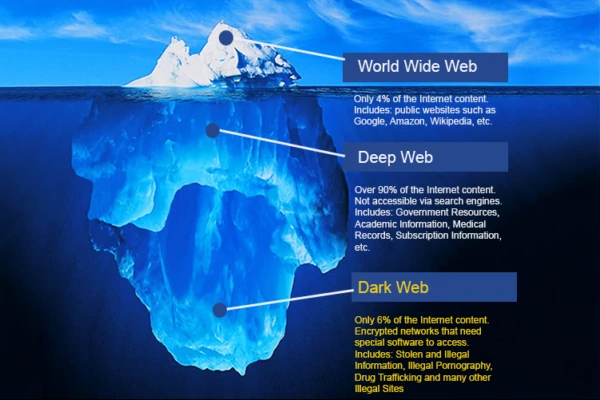The internet is like an iceberg, and what we typically access is just the tip. Beyond the surface lies an immense, concealed space known as the Darknet and Deep Web. By understanding the essence of the Darknet and Deep Web, one can navigate the digital realm more effectively and securely. This article takes you on a journey through these concealed networks, giving you insights into their functions and purposes.

Exploring the Deep Web
The Deep Web refers to any part of the internet that is not indexed by search engines like Google. In other words, you can’t stumble upon Deep Web content through a simple search. For instance, when you access your emails, you’re delving into the Deep Web. Your bank statements, personal cloud storage, and private forums are all part of this.
The Deep Web offers numerous benefits. Primarily, it protects sensitive data. Imagine if your emails or medical records were openly accessible. Moreover, the Deep Web is essential for safeguarding the privacy and identity of individuals and organizations alike. It also holds vast troves of academic content, like research papers, that are not readily available.
Additionally, companies use the Deep Web to store confidential information. For instance, an R&D department might keep groundbreaking technology secrets here before releasing them to the public.
Delving into the Darknet
Now, let’s shift our focus to the more mysterious segment of the Deep Web – the Darknet. The Darknet is an encrypted network, meaning you need specialized tools to access it. One of the most popular tools is the Tor browser. Darknet websites often end with “.onion” and are known for providing anonymity to users.
Contrary to popular belief, the Darknet isn’t solely for illicit activities. Indeed, it is infamous for black markets and the likes. However, it is also a haven for political activists and journalists in oppressive regimes. They use the Darknet to communicate and share information without fear of persecution.
For example, during the Arab Spring, activists used the Darknet to coordinate movements and share uncensored news. Whistleblowers also use the Darknet. An example of this is WikiLeaks, which has published numerous classified documents.
Distinctions Between Darknet and Deep Web
It is vital to understand the differences between these two webs. Essentially, the Darknet is part of the Deep Web, but not vice versa. The Deep Web includes all content that is not indexed by search engines. The Darknet, on the other hand, is a smaller, encrypted segment of the Deep Web.
Another distinction lies in accessibility. While the Deep Web can be accessed through standard browsers by logging into accounts or through direct links, the Darknet requires specialized tools for encryption and anonymity, such as the Tor browser.
Navigating Safely and Ethically
As you venture into the realms of the Darknet and Deep Web, it is crucial to navigate these spaces safely and ethically. Due to the anonymity provided, it’s easy to encounter illicit activities on the Darknet. Engaging in these activities is not only unethical but also illegal.
For secure navigation, make sure to use encryption tools, virtual private networks (VPNs), and safe browsing practices. Additionally, recognize the value that these nets bring to online privacy and freedom of information. They can be powerful tools for good when used responsibly.
Conclusion
In conclusion, the Darknet and Deep Web are extensive parts of the internet, hidden from search engine indexes. While the Deep Web serves as a guardian for personal and confidential information, the Darknet offers anonymity and has been used for both noble and nefarious purposes. By understanding their roles and utilizing them responsibly, we can embrace the benefits they offer while promoting a safer and more open internet for all.
